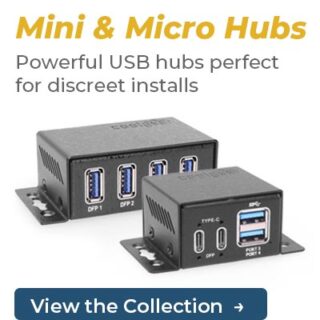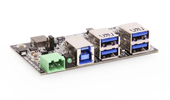The Big Idea
As the essential component in a global industry standard rail-mounting system, DIN rails are an indispensable tool in tech-heavy environments. DIN rails are designed to securely attach industrial electrical control products inside equipment rack housing cabinets, frames, or, well, just about anywhere.
Unlike busbars, they perform no connective or conductive function within a wider electrical system. Their function is purely to securely mount components such as circuit breakers, power supplies, actuators, solenoids, and, yes, most importantly, USB hubs. And the simplicity of this function makes them widely available, adaptable, and useful.
The History
‘DIN’ is an acronym for Deutsche Institut für Normung, which translates into German Institute for Standardization. The German organization developed DIN rails in the 1920s, and the now commonplace rack-mounting system was tweaked until it reached its current form in 1950s Germany.
DIN rails quickly became popular as a way of supporting components of all kinds in many industrial settings and it didn’t take long for it to spread throughout Europe and, eventually, it became a worldwide standard for industrial mounts.
Universality
The true innovation of the DIN rail is simply that it’s designed to work within a universal, standard set of widths, shapes, and mounting hardware. They fulfill a level of cross-brand compatibility that is highly valued for its flexibility within industries which experience constant flux as sites of continuous updating, innovation, and change. With the flexibility to mix and match components without having to worry about proprietary models, DIN rail standards are a no-brainer for Coolgear USB mounts.
TS35: AKA Top Hat Sections
TS35 are the most widely used DIN rails and are generally considered the standard across many different industries. They are readily available and commonly used for mounting a wide range of electrical industrial control products and components. All of Coolgear’s diverse array of DIN rail products are compatible with Top Hat (35 mm) sections.
They get their name from the shape of the rail’s cross section, which looks like an old school top hat, and they’re 35 mm from edge to edge.
Though there are several other standard types of DIN rail (listed below), they are mostly designed and implemented in contexts that require more customization and specific size or shape restrains.
Less common DIN rail includes:
TS15: Miniature Top Hat
TS32: C Sections
TSG: G-Type Sections
Coolgear’s DIN Rail Compatibility
Coolgear offers a wide array of industrial USB that have built-in DIN rail compatibility. Our DIN Rail Series includes over 20 of our industrial USB hubs that are sold with our custom DIN rail clips and screws in the packaging. You can simply snap them on to pre-installed DIN rails and rest assured everything will stay secure and in its right place.
Common applications include:
PLC, Telco Control Panels
Industrial Control and Junction Boxes
CNC and Heavy Machinery
Additionally, we sell our DIN rail clips for USBGear/SerialGear/Cablemax/CoolGear adaptors individually, allowing you to DIN rail mount most of our equipment.
Conclusion:
DIN rail has proven to be superior to nearly all proprietary mounting solutions not only for its ingenious simple design, but also because the global standardization has maintained for over 70 years. Therefore, Coolgear chooses to create DIN rail-compatible USB hubs. The advantages outweigh all other solutions.
Benefits:
- Simplicity that Saves Time
- Components slide or snap into place
- Space Saving
- DIN rails a great for tight configurations of USB hubs and other components and is ideal for use in limited spaces, helping to conserve surfaces for other applications
- Cost-Effectiveness
- Not only is DIN rail hardware generally affordable as it’s simple to fabricate and uses relatively little material,it can also reduce overall space requirements and the amount of wiring necessary
- Safety
- DIN rail promotes organized component layouts, which is great for maintenance, access, and overall safety
- Universal Protocols
- Sizing and mounting configurations are the most widely used across all other options, which gives you the broadest range of products and compatibility to choose from




















